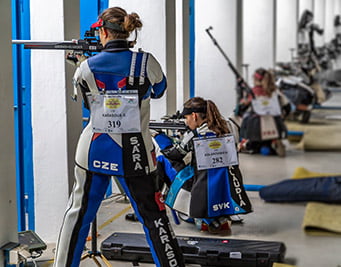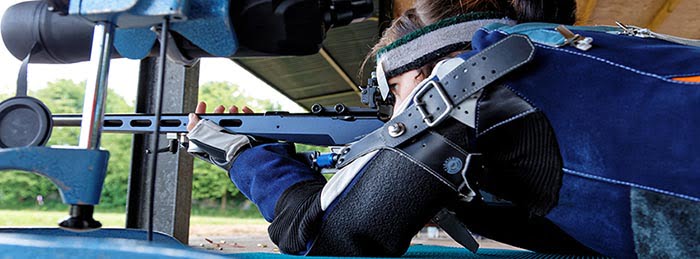You are looking ahead and thinking about your upcoming shooting training session. You know you need a plan, but what should you be focusing on?
What types of training are there?
As the main competition approaches, you want to be able to shoot a match well. This involves shooting good shots repeatedly within a time limit, as well as dealing with the pressure of the competition.

Shooting training can be split into 4 main areas, technical, tactical, physical and psychological. How you split your time between these different areas will depend on your long-term plan. When your main competition is a long way off you work on perfecting your ability to fire individual shots.
To survive the rigours of competition, you need to be fit. You don’t get fit overnight, so keeping fit will be something you would need to plan in all the time.
Technical Shooting Training
Technical training covers the bits you need to shoot the shot well. At its most basic technical training is split into 3 groups:
- Hold
- Aim
- Trigger
If you have a small hold, focused on the centre of the target and you operate the trigger well the result will be a good shot! You may notice that some of the things you thought might be in the list, like shooting position, are not in there. If you think about it though, what makes a good hold?
Hold
This section is probably the biggest area of work for the developing shooting athlete. There are so many things that can affect your hold.
Your shooting position will have the biggest impact. You need to be balanced, with the rifle supported using the minimum of tension. Once you have a position that works don’t over focus on it. You can always optimise it later.

Next in line is zero point. This is the place where the rifle points when you are in your stable, relaxed position. You need to make sure that your zero point coincides with the centre of the target for the best hold.
After that you should look at your pre-aim point and pre-aim actions so that you can approach the target in a controlled manner. The aim is to get to the target centre without adding any tensions for the best hold.
Aim
This is a little bit more than sighting in. You have many elements in the sight system and all of them need to work together for you to see a clear sight picture. Only with a clear sight picture will you be confident that you are seeing is what is actually there.
Trigger
Pulling the trigger may seem like a simple task but get it wrong and you will lose points unnecessarily. Good triggering will come with practice as well as using the right sized grip and adjusting the rifle and trigger position so that your trigger finger sits correctly on the trigger.
Tactical Shooting Training
How do you shoot a match? Just turn up and see what happens?
Your match plan lays out how you will shoot your match. It doesn’t start from ‘athletes to the line’. If you want to shoot consistently well your plan will start from the day before, or perhaps even longer than that. You need to think about:
- getting a good night’s sleep before the match.
- making sure you have drunk enough fluids in the run up to the match.
- eating enough to get you through the match, but not too close to the match so that a full stomach hampers your performance.
- How you prepare once you have got to the range
- What you are going to do in set up and sighting time
- How you are gong to shoot the match, what breaks to take, what tempo to shoot at and so on.
- It’s worth thinking about what might go wrong too and have a solution prepared.
You tactical training would involve testing and improving your match plan. Be prepared to have different plans for different ranges, different times of day and of course different weather conditions.
Physical Training for Shooting
You need to be strong to maintain your shooting position consistently over a match duration. This is not strong in the conventional sense, you don’t have to lift your kit bag over your head, but strong in the areas that matter.
The area that usually needs most work for a shooting athlete is the core. This is more than just your six pack, it includes all the muscles the support your pelvis, spine, bum, back, hips and stomach. In reality, this is just about everything from your chest down and your knees up.
On top of this, if you’re shooting standing, your knees, calves, ankles and feet also do a lot of work to keep you balanced and stable. Your head will be away from the neutral position for quite a bit of a match or training session, so your neck needs work to help maintain a comfortable head position.
Your cardio system needs to be fit too. A lower heart rate will help you in a stressful situation. You spend a lot of time holding on an out breath, which is also easier with good cardio fitness. It also helps when you shoot in extremes of temperature too. Think shooting in full kit on a range with no air conditioning in the height of summer.
Psychological Shooting Training
Shooting is just as much a mental sport as it is a physical one. If you lose focus during a match, you might miss something important. If you lose focus during a shot, then anything can happen.
The big match is a nervous affair. You probably can’t stop yourself being nervous, but you can develop strategies to deal with the physical and mental effects of the nervousness. The heightened mental state you find yourself in will highlight quite clearly any gaps or weak points in you shot routine. Mental strength and a good mental strategy will help you shoot to your strengths without exposing your weaknesses too much.
It’s difficult to test these processes out in normal training as there is nothing like a match to get you properly nervous. This means building up to the big match with other, lesser, competitions so you can try out different strategies to find the one that works best for you. Reflecting on these matches will also give you clues to drive your technical and tactical training forwards.
So, what should I do in training?
Hopefully, this article has given you some thoughts of things that you can train. Watch out for additional articles to give you more detail in each of the main areas.

